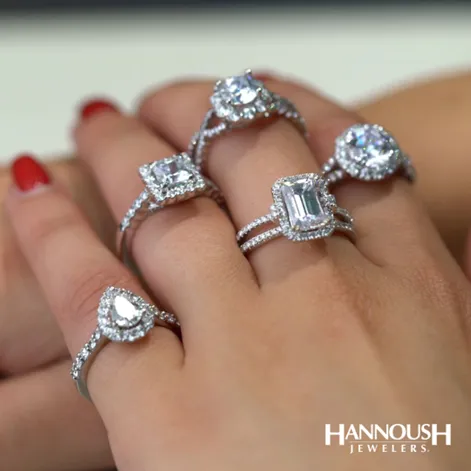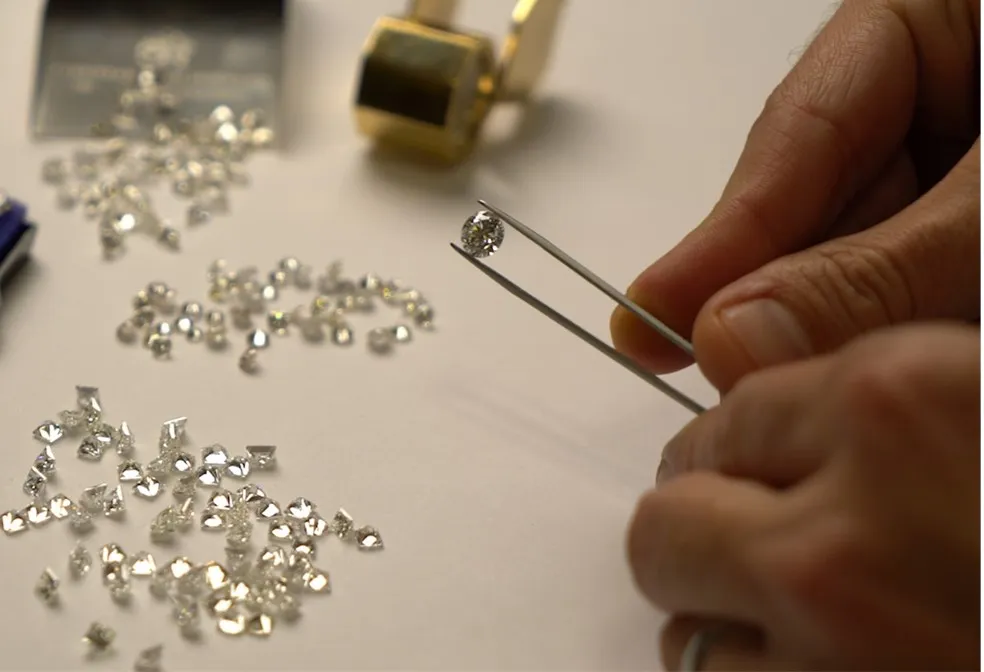
Most people who shop for diamonds are not diamond experts. For those who aren’t completely familiar with diamonds, it’s easy to become overwhelmed by the volume of information available.
Rest assured, the right jeweler can help with the diamond buying experience, explain the intricacies and differences between diamonds.
One of the most important things to consider when choosing a diamond and comparing it with other diamonds is each stone’s clarity. If you’re looking for a simple way to have diamond grading explained, this helpful guide provides a solid foundation for understanding diamond clarity.
Because diamonds are naturally formed within the earth, blemishes or inclusions could develop in many ways, most commonly by another type of mineral or other element becoming embedded in the carbon while the diamond is being formed.
That means that the clarity of diamonds is akin to the purity of diamonds.
The Gemological Institute of America (GIA) developed a clarity grading taxonomy to standardize clarity descriptions so that anyone who buys or sells a diamond can develop an accurate and consistent understanding of the clarity of diamonds in rings and other jewelry.

A flawless diamond has no inclusions or blemishes that are visible, even when examined by a professional under 10x magnification. Flawless diamonds are priced higher than other diamonds of the same size because they do not have any imperfections.
Blemishes on an IF diamond are visible but extremely difficult to find, even under magnification. Like a flawless diamond, an internally flawless diamond will be more expensive than a diamond of the same size that has a lower clarity rating.
The VVS category is divided into two grades: VVS1 and VVS2. A VVS1 diamond has some slight inclusions, but they are not visible at 10x magnification, while a VVS2 diamond has slight inclusions that begin to be visible at 10x magnification. To the untrained eye, VVS1 and VVS2 diamonds will likely appear the same, although a VVS2 graded diamond usually has a lower cost.
SI clarity in diamonds can be graded either SI1 or SI2, depending on the size and prominence of the inclusions. An SI1 diamond’s quality can be quite good and virtually indistinguishable from a VS diamond to the untrained eye, with SI2 diamond looking similar to an SI1 diamond to the naked eye.
When evaluating diamonds, it’s easy to start asking questions like, “Is I1 clarity good?” but good is a relative term.
A diamond with I1 clarity can still look brilliant and sparkle, particularly if the imperfections are in a less obvious part of the stone. Indeed, some people might prefer diamonds with inclusions because a larger stone could be purchased for a similar price as a smaller diamond with a higher clarity rating.
A trusted professional, like members of the Hannoush Jewelers staff, can help to find a diamond that meets your needs — while putting a smile on your face. Contact us or stop by our family-owned jewelry stores in Albany or Clifton Park, New York, to find the perfect diamond
Rest assured, the right jeweler can help with the diamond buying experience, explain the intricacies and differences between diamonds.
One of the most important things to consider when choosing a diamond and comparing it with other diamonds is each stone’s clarity. If you’re looking for a simple way to have diamond grading explained, this helpful guide provides a solid foundation for understanding diamond clarity.
What Is Diamond Clarity?
Diamond clarity is the scale used to describe the physical, observable characteristics of a diamond. For example, diamonds that are not classified as flawless have inclusions, which are internal irregularities or flaws, or blemishes, which are external flaws.Because diamonds are naturally formed within the earth, blemishes or inclusions could develop in many ways, most commonly by another type of mineral or other element becoming embedded in the carbon while the diamond is being formed.
That means that the clarity of diamonds is akin to the purity of diamonds.
The Gemological Institute of America (GIA) developed a clarity grading taxonomy to standardize clarity descriptions so that anyone who buys or sells a diamond can develop an accurate and consistent understanding of the clarity of diamonds in rings and other jewelry.

Diamond Clarity Classification
The 11 diamond clarity grades are grouped under six different categories. With all else being equal, such as carat and color, a diamond that is rated closer to flawless on the scale will be more valuable than one rated closer to included. A diamond inclusion chart helps visually illustrate the differences between diamond clarity gradings.Flawless
The flawless rating, also referred to by the abbreviation FL, indicates that a diamond is flawless in terms of clarity.A flawless diamond has no inclusions or blemishes that are visible, even when examined by a professional under 10x magnification. Flawless diamonds are priced higher than other diamonds of the same size because they do not have any imperfections.
Internally Flawless
Just under the FL rating is the internally flawless (IF) rating. A diamond that is rated IF also has no inclusions that are visible under 10x magnification, but it may have blemishes on the outside of the diamond.Blemishes on an IF diamond are visible but extremely difficult to find, even under magnification. Like a flawless diamond, an internally flawless diamond will be more expensive than a diamond of the same size that has a lower clarity rating.
Very, Very Slightly Included
Very, very slightly included diamonds (VVS) do have some internal inclusions, although they are not visible with the naked eye.The VVS category is divided into two grades: VVS1 and VVS2. A VVS1 diamond has some slight inclusions, but they are not visible at 10x magnification, while a VVS2 diamond has slight inclusions that begin to be visible at 10x magnification. To the untrained eye, VVS1 and VVS2 diamonds will likely appear the same, although a VVS2 graded diamond usually has a lower cost.
Very Slightly Included
A very slightly included (VS) diamond is one with minor inclusions that are observable under 10x magnification, with appropriate effort on the part of the observer. Like VVS, the very slightly included category is divided into VS1 and VS2, with VS2 inclusions being slightly easier to see under magnification.Slightly Included
When a diamond is graded as slightly included (SI), it means that the stone’s inclusions are noticeable under 10x magnification.SI clarity in diamonds can be graded either SI1 or SI2, depending on the size and prominence of the inclusions. An SI1 diamond’s quality can be quite good and virtually indistinguishable from a VS diamond to the untrained eye, with SI2 diamond looking similar to an SI1 diamond to the naked eye.
Included
Included is the final diamond clarity grade, which means that the stone has inclusions that are obvious when viewed under 10x magnification and “may affect transparency and brilliance,” according to the GIA. An included diamond may be graded I1, I2, or I3, and the inclusions may be visible to the naked eye, depending on the grade.When evaluating diamonds, it’s easy to start asking questions like, “Is I1 clarity good?” but good is a relative term.
A diamond with I1 clarity can still look brilliant and sparkle, particularly if the imperfections are in a less obvious part of the stone. Indeed, some people might prefer diamonds with inclusions because a larger stone could be purchased for a similar price as a smaller diamond with a higher clarity rating.
Find the Perfect Diamond for You at Hannoush Jewelers
Although diamond clarity can vary substantially from one stone to the next, the reality is that most people do not know the difference while simply looking at the precious gemstone.A trusted professional, like members of the Hannoush Jewelers staff, can help to find a diamond that meets your needs — while putting a smile on your face. Contact us or stop by our family-owned jewelry stores in Albany or Clifton Park, New York, to find the perfect diamond
